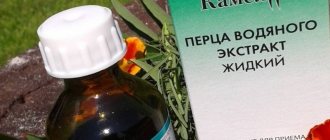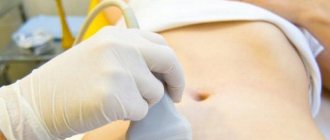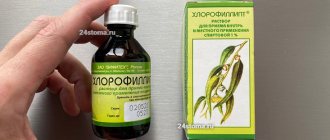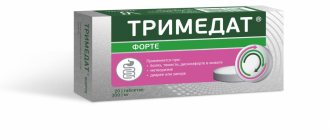Composition and release form
The drug is dispensed from the pharmacy in several dosage forms:
- Tablets have a thin soluble film coating.
- Suspension - mainly used for the treatment and prevention of children.
- Powder - represents small granules of a light shade. Used to prepare a solution.
All dosage forms are intended for oral administration. Packaged in cardboard packaging with attached instructions for use.
The active substance is nitrofurantoin. Its quantity varies depending on the form of release. Auxiliary components: calcium stearate, starch, silicon dioxide and more.
Contraindications for Furadonin
The following conditions are contraindications to taking an antimicrobial agent:
- Allergic reaction to the active or additional component.
- Severe heart failure.
- Liver cirrhosis.
- Chronic course of hepatitis.
- Serious liver disorders.
- Acute form of porphyria.
In addition, the drug is prohibited for use by children under 1 month of age and by women while pregnant and breastfeeding.
Side effects
The use of Furadonin may cause side effects such as:
- Disturbance of the digestive tract - nausea, vomiting, emaciation, pain in the epigastric region. Signs of hepatitis, jaundice and diarrhea are rarely observed.
- Dysfunction of the respiratory system - cough, chest discomfort, eosinophilia are observed, signs of asthma develop in people suffering from asthma attacks.
- Headache, dizziness, insomnia or drowsiness.
- Allergic reaction - skin rash, hyperemia, itching. Urticaria and angioedema are sometimes possible.
- Changes in laboratory blood values.
- Other manifestations include fever, myalgia, and arthralgia.
Furadonin Avexima
The incidence of adverse reactions noted when taking nitrofurantoin is given in the following gradation: very often (≥ 1/10), often (≥ 1/100, < 1/10), infrequently (≥ 1/1000, < 1/100), rare (≥ 1/10,000, < 1/1000), very rare (< 1/10,000) and frequency unknown (cannot be estimated from available data).
Infectious and parasitic diseases:
frequency unknown - pseudomembranous colitis, superinfection of the genitourinary tract, most often caused by Pseudomonas aeruginosa or Candida spp.
Blood and lymphatic system disorders:
rarely - megaloblastic anemia, leukopenia, granulocytopenia or agranulocytosis, thrombocytopenia, hemolytic anemia in patients with glucose-6-phosphate dehydrogenase deficiency.
Immune system disorders:
very rarely - lupus-like syndrome (rash, eosinophilia, fever, arthralgia), in which an increase in two or more parameters is observed in the blood serum - antinuclear antibodies, antibodies to smooth muscle or to the glomerular basement membrane and Coombs' reaction. In some cases - angioedema, anaphylaxis, autoimmune reactions associated with chronic changes in the lungs or liver.
Nervous system disorders:
often - headache;
rarely - increased intracranial pressure;
frequency unknown - dizziness, asthenia, nystagmus, drowsiness; peripheral polyneuropathy (including optic neuritis), the first symptoms of which are a feeling of numbness and burning in the legs, muscle weakness.
Disorders of the respiratory system, chest and mediastinal organs:
very rare: acute and chronic hypersensitivity reactions of the lungs, characterized by fever, eosinophilia, cough, chest pain, shortness of breath (“nitrofurantoin pneumonia”), interstitial changes in the lungs, broncho-obstructive syndrome, pleurisy. Pulmonary infiltrate or consolidation and pleural effusion may appear within hours or days of initiation of therapy; they usually resolve after stopping the drug. Subacute or acute pulmonary symptoms, including pulmonary fibrosis, may develop insidiously in patients with prolonged therapy; fibrosis may be irreversible, especially if therapy is continued after the onset of symptoms (see section "Contraindications").
Gastrointestinal disorders:
often - nausea, vomiting, lack of appetite;
rarely - diarrhea, abdominal pain, pancreatitis, inflammation of the salivary glands.
Disorders of the liver and/or biliary tract:
rarely - hepatitis, cholestatic jaundice (dose-independent and disappear after discontinuation of the drug).
Disorders of the skin and subcutaneous tissues:
often - allergic reactions (skin rashes, urticaria, itching);
very rarely - exfoliative dermatitis, erythema multiforme.
Disorders of the genital organs and breast:
very rarely - a passing disorder of spermatogenesis.
Other:
rarely - joint pain, reversible hair loss.
Instructions for use of Furadonin
The medicine must be taken after meals with a sufficient amount of water. The tablets should not be chewed, but simply swallowed whole.
The therapeutic dosage of the drug per day is 0.3 g, maximum 0.6 g for adult patients. This dose is divided into 3-4 doses per day.
For the treatment of mild forms of the infectious process, it is indicated to use 50 mg three times a day.
In acute conditions, a course lasting 7-10 days is prescribed. If no therapeutic effect is observed after the end of the course, the drug is not extended.
To prevent exacerbations of pathological processes and prophylaxis, the medicine is taken in an amount of 1-2 mg/kg body weight.
For children, the therapeutic dose is calculated individually. Per 1 kg of weight there are 5-7 mg of the drug. The total amount is divided into 4 doses during the day.
To make treatment with an antimicrobial agent more effective, it is necessary to consume more protein foods during the course.
Furadonin Avexima tablet 100 mg x20
Trade name: Furadonin Avexima
International name: Nitrofurantoin&, (Nitrofurantoin)
Pharmacological group: antimicrobial agent - nitrofuran
Pharmacological group for ATC: J01XE01. Nitrofurantoin
Pharmacodynamics:
An antimicrobial agent from the nitrofuran group, primarily for the treatment of urinary tract infections. It disrupts protein synthesis in bacteria and the permeability of the cell membrane. Effective against gram-positive and gram-negative bacteria (Staphylococcus spp., Streptococcus spp., Shigella dysenteria spp., Shigella flexneri spp., Shigella boydii spp., Shigella sonnei spp., Escherichia coli, Proteus spp.).
Pharmacokinetics:
Absorption from the gastrointestinal tract is good. Bioavailability - 50% (food increases bioavailability). The rate of absorption depends on the size of the crystals (the microcrystalline form is characterized by rapid solubility and absorption rate, short time to reach Cmax in urine). Communication with plasma proteins - 60%.
Metabolized in the liver and muscle tissue. T1/2 - 20-25 min. Penetrates the placenta, the blood-brain barrier, and is excreted in breast milk. It is excreted completely by the kidneys (30-50% unchanged).
Indications for use:
Bacterial infections of the urinary tract (pyelitis, pyelonephritis, cystitis, urethritis), prevention of infections during urological operations or examinations (cystoscopy, catheterization, etc.).
Contraindications:
Hypersensitivity, chronic renal failure, stage II-III heart failure, liver cirrhosis, chronic hepatitis, glucose-6-phosphate dehydrogenase deficiency, acute porphyria, pregnancy, lactation, children (up to 1 month).
Dosage regimen:
Orally, with plenty of water, adults - 0.1-0.15 g 3-4 times a day, children - at the rate of 5-8 mg/kg/day, the daily dose is divided into 4 doses. Higher doses for adults: single - 0.3 g, daily - 0.6 g. For acute urinary tract infections, the duration of treatment is 7-10 days. Preventive, anti-relapse treatment continues, depending on the nature of the disease, from 3 to 12 months. The daily dose in this case is 1-2 mg/kg.
Side effects:
Nausea, vomiting, allergic reactions (lupus-like syndrome, arthralgia, myalgia, anaphylaxis, chills, eosinophilia, rash), dizziness, headache, asthenia, nystagmus, drowsiness, interstitial changes in the lungs, broncho-obstructive syndrome, fever, cough, chest pain , hepatitis, cholestatic syndrome, peripheral neuropathy, pancreatitis, pseudomembranous colitis, rarely - abdominal pain, diarrhea.
Overdose:
Symptom: vomiting.
Treatment: taking large amounts of fluid leads to increased excretion of the drug in the urine. Dialysis is effective.
Interaction:
The simultaneous use of nalidixic acid and antacids containing magnesium trisilicate reduces the antibacterial effect. Incompatible with fluoroquinolones.
Drugs that block tubular secretion reduce the antibacterial effect (by reducing the concentration of nitrofurantoin in the urine) and increase the toxicity (increases the concentration in the blood) of the drug.
Description connected via INN
Instruction update date 08/10/2005
Manufacturer: Irbit Chemical Pharmaceutical Plant OJSC, Russia
Registration certificate holder: Avexima LLC, Russia
Release form: tablets 100 mg, blister packs
Dispensing conditions: by prescription
State data registration: LP-004292 dated 05/15/2017
Status of the registration certificate: expiration date 05/15/2022
Pharmaceutical article number: LP 004292-150517
Manufacturer: Irbit Chemical Pharmaceutical Plant OJSC, Russia
Registration certificate holder: Avexima LLC, Russia
Release form: tablets 50 mg, blister packs
Dispensing conditions: by prescription
State data registration: Р N002401/01 dated 07/13/2009
Date of re-registration of the RU: 11/15/2016
Registration certificate status: valid
Pharmaceutical article number: P N002401/01-080411
Interaction with other drugs
It is prohibited to take the medicine together with fluoroquinolones.
The antimicrobial effect of the drug is reduced when taken simultaneously with antacid medications containing magnesium trisilicate and nalidixic acid.
Drugs that block tubular secretion also lead to a decrease in the pharmacological effect. They, with increasing concentrations of nitrofurantoin, can increase the toxicity of the drug.
The therapeutic effect of the antimicrobial drug is suppressed in alkaline urine. Therefore, it is forbidden to combine the medicine with other drugs that increase the pH of urine.
It is not recommended to combine Furadonin with Probenecid and Sulfinpyrazone, as they inhibit the process of drug elimination.
Furadonin avexima 50 mg 20 pcs. pills
pharmachologic effect
Broad-spectrum antimicrobial agent, nitrofuran derivative.
It has a bacteriostatic and bactericidal effect against urinary tract infections. Nitrofurantoin is active against Escherichia coli, Klebsiella spp., Enterobacter spp., Proteus spp. Effective mainly for urinary tract infections.
Composition and release form Furadonin avexima 50 mg 20 pcs. pills
Tablets - 1 tablet:
- Active substance: nitrofurantoin (furadonin) 50 mg.
- Excipients: potato starch - 46.15 mg, colloidal silicon dioxide (Aerosil) - 2 mg, stearic acid - 1 mg, polysorbate 80 (Tween 80) - 0.85 mg.
10 pieces. — contour cell packaging (2) — cardboard packs.
20 pcs. — cellular contour packages (1) — cardboard packs.
20 pcs. - dark glass jars (1) - cardboard packs.
Description of the dosage form
Tablets; yellow or yellow with a greenish tint, flat-cylindrical.
Directions for use and doses
Inside, with plenty of water; adults - 0.1-0.15 g, 3-4 times a day; ;children;- at the rate of 5-8 mg/kg/day, the daily dose is divided into 4 doses. Higher doses for adults: single - 0.3 g, daily - 0.6 g.
For acute infections of the urinary tract, the duration of treatment is 7-10 days.
Preventive, anti-relapse treatment; continues, depending on the nature of the disease, from 3 to 12 months. The daily dose in this case is 1-2 mg/kg.
Pharmacokinetics
Well absorbed from the gastrointestinal tract. Bioavailability is 50% (food increases bioavailability). The rate of absorption depends on the size of the crystals (the microcrystalline form is characterized by rapid solubility and absorption rate, short time to reach Cmax in the urine). Plasma protein binding - 60%. Metabolized in the liver and muscle tissue. T1/2 - 20-25 min. Penetrates through the blood-brain barrier, placental barrier, and is excreted in breast milk. It is excreted completely by the kidneys (30-50% unchanged).
Indications for use Furadonin avexima 50 mg 20 pcs. pills
- Bacterial urinary tract infections (pyelitis, pyelonephritis, urethritis, cystitis);
- prevention of infections during urological operations or examinations (cystoscopy, catheterization, etc.).
Contraindications
- Hypersensitivity;
- chronic renal failure;
- heart failure stage II-III;
- cirrhosis of the liver;
- chronic hepatitis;
- deficiency of glucose-6-phosphate dehydrogenase;
- acute porphyria;
- pregnancy;
- lactation period;
- children under 3 years of age.
Application of Furadonin avexima 50 mg 20 pcs. pills during pregnancy and breastfeeding
The use of the drug during pregnancy and breastfeeding is contraindicated.
Use in children
The use of the drug in children under 3 years of age is prohibited.
For children over 3 years old, the dose is prescribed at the rate of 5-8 mg/kg/day, the daily dose is divided into 4 doses.
special instructions
The effect of the drug on the performance of potentially hazardous activities that require special attention and quick reactions
During the treatment period, care must be taken when driving vehicles and engaging in other potentially hazardous activities that require increased concentration and speed of psychomotor reactions (if dizziness and drowsiness occur).
Overdose
Symptoms: vomiting.
Treatment: taking large amounts of fluid leads to increased excretion of the drug in the urine. Dialysis is effective.
Side effects Furadonin avexima 50 mg 20 pcs. pills
Nausea, vomiting, allergic reactions (lupus-like syndrome, arthralgia, myalgia, anaphylaxis, chills, eosinophilia, rash), dizziness, headache, asthenia, nystagmus, drowsiness, interstitial changes in the lungs, broncho-obstructive syndrome, fever, cough, chest pain , hepatitis, cholestatic syndrome, peripheral neuropathy, pancreatitis, pseudomembranous enterocolitis, rarely - abdominal pain, diarrhea.
Drug interactions
The simultaneous use of nalidixic acid and antacids containing magnesium trisilicate reduces the antibacterial effect. Incompatibility with fluoroquinolones. Medicines that block tubular secretion reduce the antibacterial effect (by reducing the concentration of nitrofurantoin in the urine) and increase the toxicity (increases the concentration in the blood) of the drug.







